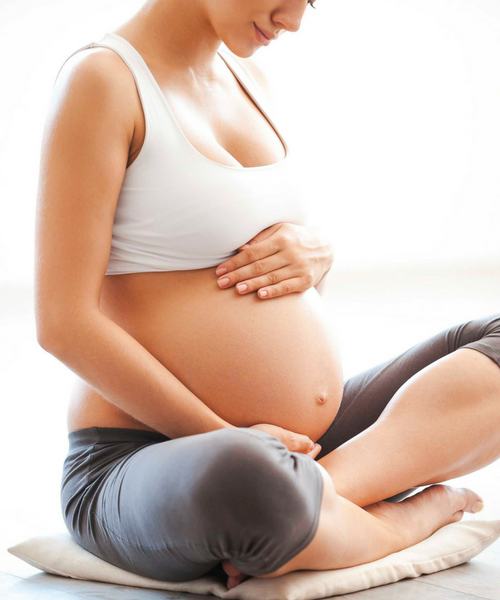By: Dr Rita Khanna
Yoga and Maternity

Yoga is a great way to enjoy pregnancy, to align your body optimally for healthy carriage and delivery of the baby, to provide breathing and relaxation techniques during pregnancy and labour. Prenatal Yoga is a much gentler variant, which focuses on relaxing the hips in preparation for labour, reducing lower back pain and swellings.
It helps keep you & your baby calm and relaxed. Smooth pregnancy and a natural childbirth are just some of the benefits of Yoga. But more importantly, Yoga does wonders on the physical and mental development of the foetus. Happy Mommies make happy Babies. Yoga has 6 vital tools for pregnancy. When followed together, they work wonders on your health and your capability to have a smooth pregnancy. These are:
Yoga exercises
Breathing or Pranayama
Bandhas
Meditation
Deep Relaxation
Diet
YOGA EXERCISES
Get in touch with a trained Guru who can guide you on the exact asana or postures to use. Most Gurus can alter the postures to suit you depending on the aches and pains you have developed due to pregnancy.
One should not do any kind of exercise for three months after conception. Regarding Yogasanas, the practice of Shavasana can certainly be done.
Yes, if there is a habit of doing household work and going for a long walk, it should not be discontinued. It will be helpful in the development of the child.
After five months of pregnancy, Katiutthanasana & Balasana can be done (described below). All flexibility exercises, without bending forward and without abdominal rolling should be done by sitting in Sukhasana (crossed legged).
If one sits on her feet and walks back as if she is cleaning or mopping the floor for five minutes in the morning, afternoon and evening, the pelvic girdle stiffness decreases and it gets relaxed. Also, the hipbones and its muscles get relaxed and become soft.
BREATHING OR PRANAYAMA
Aumkar, Bhramari, Anulome Vilome Pranayama, Sivananda Pranayama are some of the most beneficial techniques for women health during pregnancy. Good breathing and control of Prana (energy) are vital, because just like the nutrients you provide your baby from your food, you are also responsible for providing him/her with high quality oxygen and prana from the air you breathe.
These phenomenal techniques also help to release emotional tension during labour.
MULABANDHA
Moolabandha has powerful effects on a woman’s reproductive organs. By repeatedly contracting the anus muscles up and on inner side, the elasticity of vaginal opening increases. Due to this, the child comes out easily and the lady enjoys painless delivery and pleasant childbirth.
MEDITATION
During pregnancy, the way you are feeling & thinking will affect the child too. Meditation will help you to think positive & explore your inner self. It would establish a connection with your child that is difficult to explain.
YOGA NIDRA / DEEP RELAXATION
Yoga nidra is particularly effective during pregnancy for physical and mental relaxation as well as for childbirth preparation.
DIET
It is better to take simple, fresh and vegetarian diet as far as possible. It can be digested easily. It is nutritive and very beneficial for the health of the mother and the intrauterine foetus.
I am describing two exercises & one Pranayama below. Before you start with any kind of exercise, it is important to seek permission from your gynaecologist.
KATI-UTTHANASANA
Kati means waist and Utthan means raised
· Take a Yoga mat and lie on your back on the mat with your palms on the sides, both the legs straight on the ground.
· Now bend both the legs one after the other slowly from the knees and bring them right up to the buttocks.
· Keep distance between the legs equal to the distance between the shoulders.
· Now transfer the weight on both the legs and both the hands, raise the waist as much as possible, and remain steady. Breathe normally.
· Hold the position for 5 to 10 breaths.
· This asana helps in toning your hips, lower back and your abdomen muscles.
BALASANA (CHILD’S POSE)
This exercise helps open up your chest and pelvis & increases blood circulation. Rejuvenates the brain cells & relieves fatigue.
Sit in Vajrasana with knees a little wider than your hips. This will create more room around the belly. It also allows deeper breathing.
Place your forehead on the floor with your arms out in front or at your sides. Do whichever you feel is more comfortable.
If you have difficulty sitting on your heels in this pose, place a thickly folded blanket / cushion between your back thighs and calves.
SIVANANDA PRANAYAMA
Take a Yoga mat and lie on your back on the mat with your palms facing upwards. Bend both the knees. Keep the knees & feet apart.
Take your mind to the solar plexus (navel).
Watch the breath, breathe in as slow as possible and breathe out as slow as possible.
While breathing in your stomach is rising, while breathing out your stomach is falling.
· Remain a witness to the breath so that the breathing in and breathing out do not happen without your knowledge.
· You must remain happy in this watchfulness.
· You can practice Sivananda Pranayama for a period of ten to fifteen minutes in the morning, noon, evening as well as late night, whenever your stomach feels light, about three hours after meals.
· By this Pranayama, you will get mental soundness. It is very useful panacea for blood pressure, mental tension and irregularity of the stomach.



